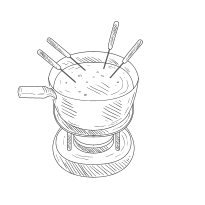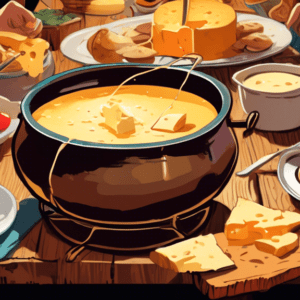How to Make Cheese Fondue: A Step-by-Step Guide
Few culinary experiences rival the sheer indulgence and communal joy of
sharing a pot of molten cheese. Cheese fondue, with its origins in the
mountainous regions of Switzerland, has transcended its humble beginnings to
become a globally adored dish synonymous with warmth, conviviality, and pure
cheesy bliss.
Whether you’re a seasoned fondue aficionado or a curious beginner eager to
dip your toes (or rather, bread cubes) into the world of melted cheese, this
comprehensive guide will equip you with all the knowledge and techniques
needed to craft a fondue experience that will have your taste buds singing.
Choosing the Right Cheese: The Foundation of Flavor
The soul of a remarkable cheese fondue lies in the careful selection of its
cheesy core. While countless variations exist, a classic Swiss fondue
typically revolves around a harmonious blend of Gruyère and Emmental cheeses.
Let’s delve into their unique characteristics:
-
Gruyère: This cheese, hailing from the Gruyère region of
Switzerland, boasts a robust, slightly nutty, and earthy flavor profile
that forms the backbone of the fondue. Its exceptional melting
capabilities contribute to a velvety smooth and luxuriously creamy texture. -
Emmental: Known for its signature holes (or eyes),
Emmental adds a mild, sweet, and slightly fruity counterpoint to the
assertive notes of Gruyère. Its ability to melt evenly further enhances
the fondue’s desirable consistency.
While the Gruyère-Emmental duo reigns supreme, don’t hesitate to experiment
with other cheeses to customize your fondue experience. Fontina, Comté,
Appenzeller, and even a touch of sharp Cheddar can add intriguing layers of
flavor and texture.
Essential Equipment: Gearing Up for Fondue Success
Before embarking on your cheese-melting adventure, ensure you have the
following tools at your disposal:
-
Fondue Pot: The heart of the operation! Choose a pot
specifically designed for fondue, typically made from heat-resistant
ceramic, cast iron, or stainless steel. These pots often come equipped
with a stand and burner to maintain the ideal serving temperature. -
Fondue Forks: These long-stemmed forks with curved or
two-pronged ends are specially designed for dipping without losing your
precious cargo in the molten cheese. -
Heat Source: Depending on your fondue pot, you’ll need a
heat source to keep the cheese molten. Options include a small gas burner,
a spirit lamp, or an electric heating element. -
Cutting Board and Knife: For preparing your dipping
delights. -
Serving Platters and Bowls: For presenting your array of
dipping options. -
Whisks or Wooden Spoons: For stirring and incorporating
ingredients. -
Measuring Cups and Spoons: For precise ingredient
measurements.
Ingredients: Gathering Your Cheese-Melting Arsenal
With your equipment ready, let’s assemble the key components of a classic
Swiss cheese fondue (adjust quantities based on your desired serving size):
-
Cheese:
- 1 cup (4 ounces) grated Gruyère cheese
- 1 cup (4 ounces) grated Emmental cheese
-
Liquid:
- 1 cup dry white wine (such as Sauvignon Blanc or Pinot Grigio)
-
Cornstarch:
- 1 tablespoon cornstarch
-
Garlic:
- 1 clove garlic, halved
-
Lemon Juice:
- 1 teaspoon fresh lemon juice
-
Nutmeg:
- A pinch of freshly grated nutmeg
-
Black Pepper:
- Freshly ground black pepper to taste
Step-by-Step Guide: The Art of Crafting Perfect Cheese Fondue
Now, with our ingredients prepped and our tools at the ready, let’s embark
on the step-by-step journey of creating a cheese fondue that will impress
even the most discerning palate:
Step 1: Preparing the Fondue Pot
Begin by rubbing the inside of your fondue pot with the cut side of the garlic
clove. This imparts a subtle but essential garlicky essence to the cheese
mixture. Discard the garlic clove.
Step 2: Combining the Cheese and Cornstarch
In a large bowl, toss the grated Gruyère and Emmental cheeses with the
cornstarch. This step ensures that the cornstarch is evenly distributed,
preventing lumps and promoting a smooth, velvety texture.
Step 3: Heating the Wine
Pour the dry white wine into the fondue pot and heat it over medium heat until
it simmers gently. Avoid boiling the wine, as this can make the fondue
bitter.
Step 4: Gradual Cheese Addition
Reduce the heat to low. Gradually add the cheese-cornstarch mixture to the
simmering wine, stirring constantly in a figure-eight motion. This gentle
heating and stirring process allows the cheese to melt slowly and evenly
without separating.
Step 5: Achieving a Smooth Consistency
Continue adding the cheese gradually, stirring until the mixture is completely
melted and smooth. If the fondue seems too thick, you can adjust the
consistency by adding a tablespoon or two of additional warmed wine.
Step 6: Adding the Finishing Touches
Stir in the lemon juice, nutmeg, and black pepper. Taste the fondue and adjust
the seasonings to your liking. If desired, you can also add a splash of
kirsch (cherry brandy) for a traditional Swiss touch.
Step 7: Serving and Enjoying
Transfer the fondue pot to its heat source and keep it warm over low heat.
Arrange your desired dipping items on platters or in bowls around the fondue
pot. Provide each guest with a fondue fork and encourage them to dip, swirl,
and savor the cheesy goodness.
Dipping Delights: A World of Fondue Companions
The beauty of cheese fondue lies not only in its creamy, cheesy base but also
in the endless possibilities for dipping. From crusty bread to crisp vegetables,
the options are limited only by your imagination. Here are some classic and
creative dipping ideas to elevate your fondue experience:
Breads:
- Crusty baguette slices
- Sourdough bread cubes
- Pretzel bites
- Mini croissants
Vegetables:
- Blanched broccoli florets
- Steamed asparagus spears
- Cherry tomatoes
- Bell pepper strips
- Baby potatoes
Proteins:
- Cooked shrimp
- Grilled chicken or steak cubes
- Smoked sausage slices
- Meatballs
Other Delights:
- Apple slices
- Pear wedges
- Roasted mushrooms
- Pickled onions
Tips for Fondue Success:
-
Grate the Cheese: Pre-grating the cheese ensures that it
melts quickly and evenly, preventing clumping. -
Use Dry Wine: The acidity in dry white wine helps break down
the cheese and create a smooth fondue. Avoid sweet wines, as they can make
the fondue overly sweet. -
Low and Slow: Melt the cheese over low heat, stirring
constantly, to prevent scorching or separating. -
Mind the Consistency: If the fondue is too thick, thin it
out with a splash of warmed wine. If it’s too thin, whisk in a teaspoon of
cornstarch mixed with a tablespoon of wine. -
Don’t Overcrowd the Pot: Too many dipping items in the
fondue at once can cool it down, making the cheese solidify. -
Keep it Warm: Maintain the fondue’s ideal temperature by
keeping it over low heat on a heat source. -
Embrace Experimentation: Don’t be afraid to get creative
with your cheese blends and dipping choices!
The Joy of Sharing: Fondue as a Culinary Social Experience
Beyond its delectable flavors and textures, cheese fondue embodies the essence
of shared dining. It’s a dish best enjoyed in the company of friends and
family, gathered around a bubbling pot of molten cheese, their laughter and
conversation mingling with the aroma of melted goodness.
So, gather your loved ones, prepare your dipping arsenal, and embark on a
cheese-filled adventure that will tantalize your taste buds and create lasting
memories. With a little practice and a lot of enthusiasm, you’ll master the
art of crafting perfect cheese fondue, transforming any occasion into a
celebration of culinary delight.

